| Siren intermedia | |||||||||||
| Lesser Siren | |||||||||||
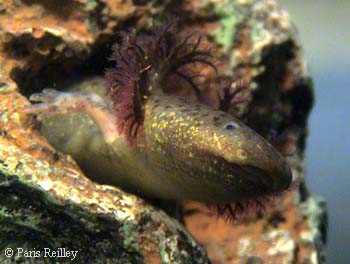
|
|
||||||||||
Description
Lesser sirens are a large salamander with many neotonic traits, including exposed gill tufts throughout adult life. Lesser sirens lack hind limbs and have front limbs that have 4 toes on each foot. (In contrast, dwarf sirens, Pseudobranchus spp. have 3 toes on each foot, and the Amphiumas have 4 small legs.) Juvenile lesser sirens have red to yellow colors banding the head and (except for Siren i. intermedia) all have distinct stripes running down the body. As the siren grows older these patterns fade until the plainer adult coloration is reached. Sexually mature lesser sirens have a dorsal pattern that is usually an olive green to grayish blue or black. Some individuals may have scattered spots on the dorsal surface. The ventral surface is usually lighter in color, tending more towards a light gray color. Lesser sirens can range in size from 7 to 27 inches (17 - 69 cm) depending on the subspecies. There are 2 subspecies of lesser sirens recognized at this time, although research is indicating that there may be more species. They are the eastern Lesser Siren (Siren i. intermedia) and the Western Lesser Siren (S. i. nettingi). The easiest way to distinguish between the subspecies is to know the collection locality, otherwise costal groove counts and colors may give a clue to the identity.
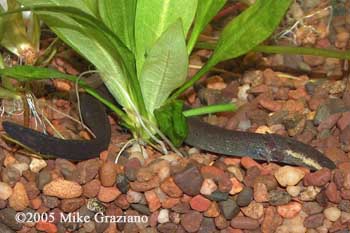
|
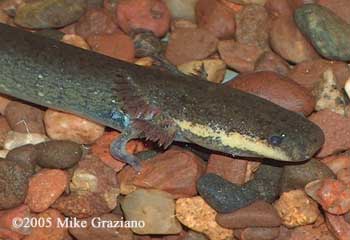
|
Distribution and Habitat
Lesser sirens range from North Carolina south to
southern-central Florida, west to east and southern Texas
and north from Texas in the Mississippi valley to Indiana
and Illinois. Localized colonies may also be found in
southeastern Virginia, northeastern North Carolina,
southwestern Michigan, and northern Indiana. Lesser sirens can be found inhabiting the mud and debris that are located on the bottom of still and slow moving waters
such as sloughs and ponds. The habitat doesn't
necessarily need to be a permanent body of water. If the
body of water temporarily dries up the sirens will burrow
into the bottom and aestivate. Juveniles can aestivate
for approximately 12 to 14 weeks before starving to death, while well-fed adults can aestivate for at least 16 weeks.
In the wild lesser sirens feed upon snails, worms,
aquatic invertebrates, and occasionally fish. However, while feeding a fair amount of aquatic vegetation is also
ingested. The algae and vegetation tends to be poorly
digested and may just be an artifact of the manner in
which the sirens feed.
Conservation Status
Until the number of species and subspecies has been finalized, the
conservation status will be difficult to determine.
However, habitat fragmentation may have a serious impact
on the viability of this species.
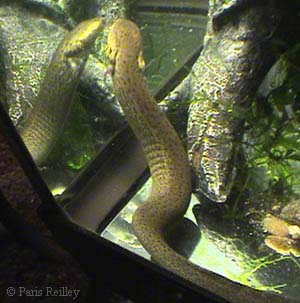
|
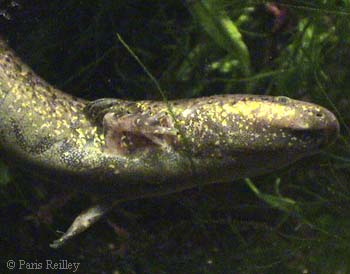
|
Housing
Housing should depend upon the size of the animal, with small juveniles housed in aquariums of 10 gallons (38 liters) or larger. Larger animals are housed in appropriately sized larger aquariums with a tight fitting lid. An adult S. i. intermedia can be comfortably housed in a 20 gallon long (76 liter) aquarium. An adult S. i. nettingi may require an aquarium as large as 40 gallons (151 liters).
The aquarium should be filtered with an appropriate sized canister or submersible filter. Avoid using a hang-on-tank filter, as gaps in the lid of the aquarium may permit escape. Water quality should be maintained through weekly 10-20% water changes, while more frequent changes are indicated if ammonia and/or nitrite is detected. The aquarium can be aquascaped with stones that are too large for the salamander to ingest, as well as with floating plants. Planting the aquarium is not really practical, as the siren will disrupt the plants during its evening activity. A shelter that the siren can hide inside or under should also be provided to help prevent stress. Appropriate shelters can be constructed from PVC pipe cut to length, pieces of drift wood, or rock shelters that have been siliconed together to provide stability. The siren will primarily be active during the evening and nighttime hours. However, lesser sirens will also learn a feeding schedule and become active around feeding time.
Lesser sirens do best when the enclosure temperature is maintained between 65-80°F (18-26°C) with a twice a week feeding to satiation in adults and daily feeding for juveniles. With juveniles, all uneaten food should be removed with 24 hours to prevent the aquarium from fouling. With good care, lesser sirens can live for more than 14 years in captivity.
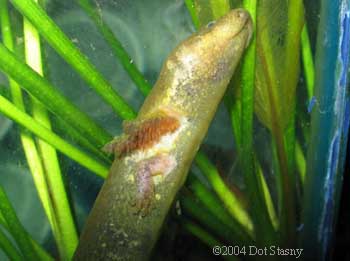
|
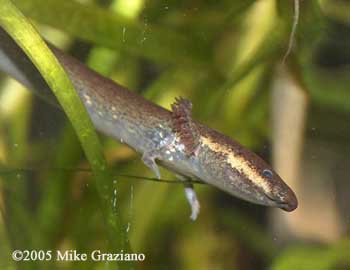
|
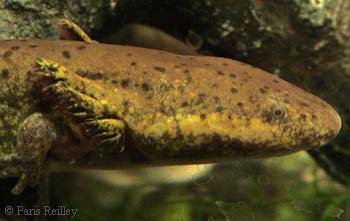
Female S. i. intermedia. Contrast the head shape to the male below. |
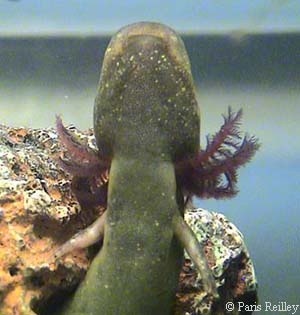
|

Male S. i. intermedia, showing enlarged masseter muscles that give males their characteristic head shape. |
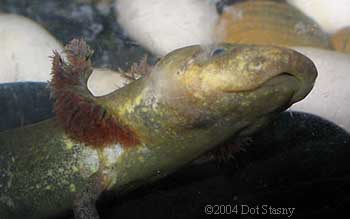
|
Feeding
Once acclimated, lesser sirens are aggressive feeders. If more than one siren is housed in an aquarium, then hand feeding with tweezers may be necessary to prevent one siren from monopolizing the food supply. Juveniles can be fed on black worms, tubifex worms, daphnia,
small snails, bloodworms, white worms and small red worms.
As the siren grows, the size and amount of the food offered can be increased until the salamander is on the
adult diet. Adult lesser sirens can be fed large earthworms, pinkie mice, small fish, and pieces of meat.
However whole prey items are the best food items possible
as this decreases the probability of dietary deficiencies.
If fish are being used as part of the diet, then care
should be taken to not feed an exclusive diet of fish.
This can lead to thiamin deficiencies as well as fatty liver problems, which are most commonly associated with a
diet of either frozen fish or goldfish.

S. i. intermedia breeding tank. It is a large tank with cold slowly flowing water.
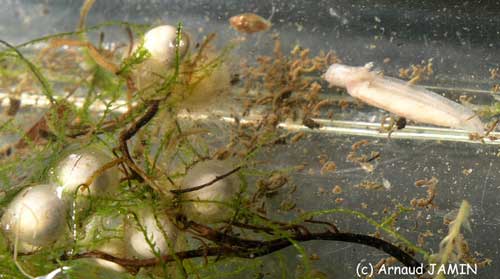
S. i. intermedia eggs and hatchling.
Breeding
Sexual maturity is usually reached in two to three years depending upon the population involved. Adult males can be identified by the enlarged masseter muscles causing the temporal region of the head to appear swollen.
During the breeding season, male lesser sirens may engage in biting behaviors. Spent females have been observed with multiple bites possibly indicating that biting is part of courtship in this salamander. Also, males have been observed with bite marks, indicating either mate guarding behaviors or territorial encounters. The breeding season is variable depending on geography, with the southern localities breeding earlier. Southern populations may start as early as December-March in central Florida and March to April in the Carolinas. The eggs are deposited primarily in large masses that may consist of several layers of eggs. The eggs are a dark brown color and have a sticky gel coat adhering to each other as well as to plants, twigs, and roots.
The egg mass may number between 200 and 700 eggs. The eggs hatch in 1.5 to 2.5 months, estimated based on the collection of newly hatched larvae in appropriate habitats. It is unclear if the sirens collected in the vicinity of the clutches are engaged in guarding the clutch or are incidental to the area, as appropriate habitats may have a very large population of these salamanders (up to 1.1 animal/square meter, Petranka; 1998). Lesser sirens have been collected with lesser siren eggs in their digestive tract. It is uncertain whether this is a female guarding a clutch and feeding on the eggs in her own clutch or other sirens predating upon egg clutches. It is unknown at this time if lesser sirens have internal or external fertilization of their eggs. Captive reproductions of this species have rarely been recorded. If breeding is to be attempted, the day length should be shortened while lowering the enclosure temperature.
Raffaelli reported a successful captive breeding in 2007. About 60 eggs produced, and about a dozen were fertile. The adults had been kept at 7-8°C (44-46°F), and the eggs were deposited under a rock in spring when the water temperature reached 12°C (54°F). Adult activity was observed under the rock, suggestive of external fertilization and/or parental care of the eggs. See References below for link to additional information.

S. i. intermedia juvenile several months after hatching. 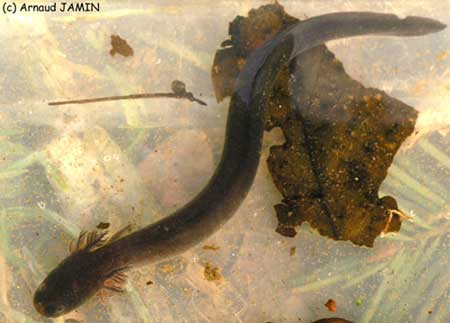
S. i. intermedia juvenile several months after hatching. |
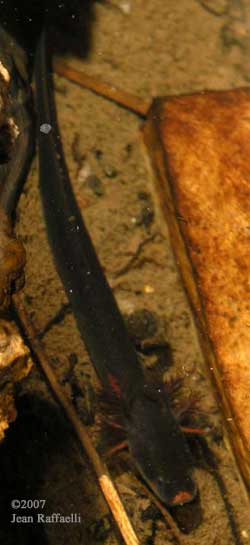
S. i. intermedia larva several weeks after hatching. Size is approximately 7 cm (3 in). |
References
Conant, Roger; Collins, Joseph T.; 1991, Reptiles and Amphibians of Eastern and Central North America, Houghton Mifflin Company, Boston.
Petranka, James W.; 1998, Salamanders of the United States and Canada, Smithsonian Institute Press, Washington.
Raffaelli, Jean; Jamin, Arnaud. Personal communication and information posted on this forum thread.
© 2001 Ed Kowalski. Posted July 2001. Breeding information revised March 2008.
